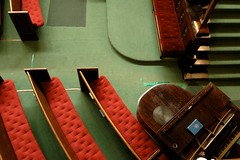
Spent the better part of Saturday on a speed dating spree, hosted by the Chicago Cultural Center’s Neighborhood Tours, visiting some of the heavy hitters of ecclesiastical architecture of Chicago, including St. Alphonsus, St. Benedict, and St. Clement [1].
But like a smitten pilgrim I was slain in the Spirit on the first stop -- the Second Presbyterian Church of Chicago -- and spent the rest of the morning regretting that I ever got back on the bus.
Second Pres grew from prominence out of a small group of Presbyterians who hooked up at Fort Dearborn once a long time ago. The Presbyterians split into two groups around 1842 over the cause of Abolition, the way churches split today with such frequency over the issue of gay rights. Second Pres was the more conservative collective of the two, composed of congregants who felt that enslaved peoples shouldn’t be freed until there was an economic strategy in place to support them in their freedmen status. It’s probably no surprise that this congregation would evolve to be the conservative well-heeled businessmen and industrialists who populated Prairie Avenue and built domestic fortresses like the Glessner House.
Politics aside, they did all right outfitting their church.
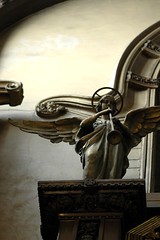
The neo-gothic exterior was designed by James Renwick, the fellow behind St. Patrick’s in New York. Renwick took a pass at Second Pres twice: the first structure was destroyed in the Great Chicago Fire; the second one stands today at the intersection of Michigan and Cullerton. After another fire destroyed the roof over the sanctuary and inflicted severe water and smoke damage in the nave, the congregation hired member Howard Van Doren Shaw to rebuild and restore the interior.
Shaw dialed up his buddy and fellow church member Frederic Clay Bartlett and together they kicked off an Arts & Crafts Pre-Raphaelite mashup that has all the hallmarks of Protestants going to meeting. Divergence, vernacular and rambling symbolism reigns.
Unlike the soaring Catholic cathedrals that we saw later in the day where the stained glass panels flow cohesively in a concise story line about wretchedness and redemption, the Second Pres art glass panels are all over the narrative map.
Two Edward Burne-Jones stained glass panels adorn the narthex, pious copies of the Oxford panels of Saints Cecilia and Margaret.
(Wait: let me say that again. SIR EDWARD FRAKING BURNE-JONES.)

Over the choir loft a riotous Ascension by William Fair Kline plays out in full technicolor across one master panel and five smaller accompaniments.
Of the twelve stained glass panels that line the main sanctuary the majority are by Mr. Louis Comfort Tiffany himself, and yes, no, of course not one of them coheres with another, but each of them is radiant (even for want of cleaning) and uncompromising in its magnificence.
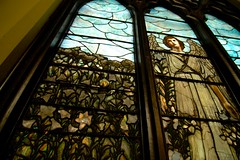
Of the Tiffanys there’s a jewel glass panel, several pastorals, and a handful of painted figures (only the faces of the Tiffanys are painted -- the remainder of the color is infused in the glass) including an angel and a Jesus figure who is tricked out to look a little like Edgar Allen Poe (as our guide, the incomparable Al Walavich pointed out).
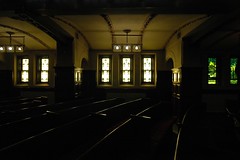
Don’t even get me started on the fine finishings, among them: the suspended flat panel stained glass light fixtures evoking the triune God and, quite possibly, the pomegranate. The six variably sized globes that swing among other chandeliers at the altar and may well represent the spinning planets.
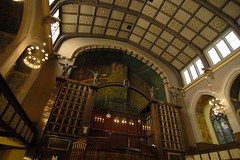
I won't go on too long about the lovely mural work that is everywhere, except to say that I felt the most captivating piece in the church, and also the most illusive to capture on camera (I failed completely) is Frederic Clay Bartlett’s Tree of Life, which adorns the altar. Pure Arts & Crafts, the mural is all pattern and repetition. Dark and leafy, arching ever upward, it reminds me of the extraordinary wooden altarpiece of the cathedral of Santiago de Atitlan carved by the master Diego Chavéz and his brother Nicholas in the way it tethers spiritual aspirations with the grit and power and persistence of the earth.
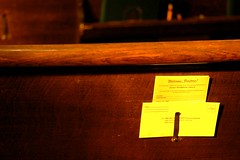
So, in a word: Go. Visit a good long while. And while you’re at it leave the Friends of Historic Second Church a few farthings for the privilege so that they can continue the work of repairing the patched and torn carpet and cleaning the glass and protecting this treasure so that it will endure.
[1] Turns out St. Clement is host to Danny Thomas’ St. Jude, the effigy to which Mr. Thomas targeted his ardent appeal for career success, and the very same saint that he built a hospital to honor when things took off. Also of interest for those of us who love Elaine Stritch too much: Thomas formulated his plans for his hospital with Cardinal Stritch, Ms. Stritch’s uncle.






4 comments:
lovely stuff!
I had the same experience when I visited this church - I couldn't believe my eyes! It's spectacular! How is it possible that such an important building should have fallen into such disrepair? Foundations should be falling all over each other to support the restoration of this Arts & Crafts jewel.
Hello mate nnice post
The stained-glass windows at Second Presbyterian Church sound incredibly beautiful.
Post a Comment